May 2017
Several of the large “omnibus” bills under consideration in the Minnesota Legislature have provisions that would change long-standing environmental protections and slow down MPCA services. MPCA leadership has testified that these provisions will seriously hamper our ability to protect Minnesota's air, water and land resources, and interfere with our support of individuals, local governments and businesses. More information about the possible impacts is available on the MPCA 2017 legislative update webpage.
State law requires the MPCA to develop watershed restoration and protection strategies for each of the 80 major watersheds in Minnesota every 10 years. Local government partners use the strategies to develop their local water management plans. Right now, the legislature is cutting more than $1.4 million from this program, which will delay local water restoration or cleanup plans. We support the Governor’s recommendation to fund this program at $20.463 million over the next biennium.
Back to top
 The State of the River - past, present, and future, headlines the eighth Minnesota River Congress May 18 at the Redwood Falls Community Center. Everyone
who cares about an inclusive, citizen-led Minnesota River improvement effort is welcome to attend. The Congress starts with a 'networking fair' 4:30-6 p.m. with exhibits and short presentations from organizations. Following a 6 p.m. meal, opening remarks at 6:30 p.m. will address Gov. Dayton's "25 by 25" goal, a 25 percent improvement of the state's waters by 2025. At 6:45 the State of the River will feature:
- History of progress in the Minnesota River Basin, Kim Musser, Water Resources Center, MSU, Mankato;
- Casein the Basin: What we have learned and what you need to know about water quality, pollutant sources, and delivery dynamics within the basin, Pat Baskfield, Minnesota Pollution Control Agency;
- Doing Our Part: Farmer panel, Warren Formo, moderator;
- Minnesota Agricultural Water Quality Certification Program;
- Collaborative for Sediment Source Reduction, Karen Gran, UMD;
- Greater Blue Earth River Basin Alliance actions, Clark Lingbeek, Cottonwood SWCD;
- CREP history and its future in the Minnesota River Basin, John Jaschke, Board of Water and Soil Resources.
Individual attendance: $20. Register online. No charge for young adults under 19 or with a college ID. Exhibit table fee: $30. Register online. Make
checks payable to CCMR (Coalition for a Clean Minnesota River) PO Box 488, New
Ulm, MN 56073. For more information contact Scott Sparlin, 507-276-2280, sesparlin@gmail.com.
Back to top
|
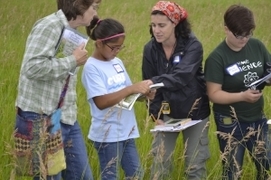 Land Stewardship Project’s 2017 Prairie BioBlitz is scheduled for Saturday, June 24, at Glacial Lakes State Park south of Starbuck in Pope County. A BioBlitz is an intense period of biological surveying in an attempt to record as many living species possible in a designated area. Groups of scientists, naturalists, and volunteers conduct this survey over a specific period of time.
In partnership with the Chippewa River Watershed Project (CRWP) and Clean Up the River Environment (CURE) it will showcase Minnesota public lands, featuring the U.S. Fish and Wildlife Service and the Dept. of Natural Resources. Learn about and take species surveys on land managed by the Fish and Wildlife Service, as well as on native prairie in Glacial Lakes State Park and a private prairie area managed with a Fish and Wildlife Service easement. The event is appropriate for all ages, and organizations are welcome. RSVP and sign up for volunteer shifts at SignUp.com. You may also contact Robin Moore to sign up for shifts. Robin Moore, e-mail, 320-321-5244. Photo from LSP website.
Back to top
|
 A new study from the DNR provides a wide-ranging and in-depth look at the Lower Minnesota River watershed. The Watershed Characterization Report focuses on conditions in rural counties of the High Island Creek, Rush River,
Sand Creek, and Le Sueur Creek watersheds. Information on watershed characteristics, hydrology, connectivity,
geomorphology, and restoration strategies will help inform stressor
identification and produce Watershed Restoration and Protection
Strategies.
Significant channel alteration,
drainage of wetlands, and changes in vegetative cover have compounded the
naturally erosive nature of the Lower Minnesota
River watershed. The resulting highly turbid streams create areas that lack habitat due to high sediment loads and channel
succession processes.
Increases in water storage, soil
health, and perennial cover are restoration strategies that will help
address the hydrologic changes. Due to the degree of incision and lack of floodplain connectivity that cause nearly every bank to be erosive in many of the streams, streambank stabilization
practices are recommended mainly to protect infrastructure. For more information, see the five-page summary and report online or contact Jon Lore, Mankato DNR office, (507)389-8804.
Back to top
|
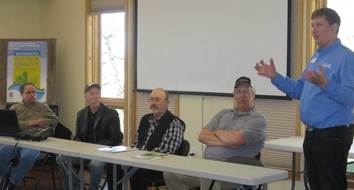 The annual Earth Day festival April 22 at Prairie Woods Environmental Learning Center near Spicer featured a panel discussion among area farmers involved in the Minnesota Agricultural Water Quality Certification Program. Grant Pearson of the Stearns County SWCD set the stage with an overview of the program.
The MAWQCP is a voluntary program for farmers and landowners that protects the state’s water resources. Since the program started in 2014, 365 Minnesota farms have been certified. They have added 628 new conservation practices that have kept over 12.1 million pounds of sediment out of rivers while saving nearly 17.4 million pounds of soil and 7,414 pounds of phosphorus on farms each year. Those numbers will increase as more landowners enroll in the program. Photo L-R: Grant Pearson, Rich Radtke, Ken Schefers, Jim Barchenger, and Lucas Sjostrom, Minnesota Milk Producers executive director.
Back to top
|
|
Starting in July Gov. Mark Dayton plans to host a
series of 10 town-hall-style meetings across the state to discuss water quality. They are part of the
governor’s goal of improving water quality 25 percent by 2025. A study by state agencies found about 40 percent of Minnesota’s waters are polluted or impaired. Gov. Dayton has made improving the state’s water quality a priority of his second and final term as governor. Meeting locations and dates:
- Rochester – July 31
- Marshall – Aug. 16
- Mankato – Aug. 17
- Crookston – Sept. 5
- St. Cloud – Sept. 6
- Ely – Sept. 12
- Bemidji – Sept. 13
- Minneapolis – Sept. 26
- Burnsville – Oct. 4
- Maplewood – Oct. 5
Additional information will be available at www.eqb.state.mn.us/25by25.
Back to top
|
|
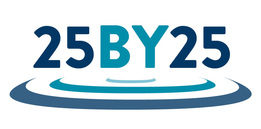 |
The Board of Water and Soil Resources has scheduled three workshops
on the Minnesota Public Drainage Manual. They are for
county commissioners, auditors, and attorneys; watershed district managers,
administrators, and secretaries; drainage inspectors; viewers; private drainage
attorneys; and involved landowners. The workshops will be from 10 a.m. to
3:30 p.m. on:
- May 22, Minnesota State
Community and Technical College, Moorhead
- May 23, Coyote Moon Event
Center, St. Cloud
- May 25, New Ulm Conference
Center, New Ulm
Registration information and the workshop agenda will be sent
out near the end of the week of April 17. The agenda will involve the lead
writers for Chapters 2, 3, 4 and 5 of the MPDM and others knowledgeable about
Minnesota drainage law. The $25 fee will cover food (lunch and breaks) and
meeting room costs.
Back to top
|
Recent video from
KDLT TV (Sioux Falls) captured a story on trout stocking in the Redwood
River at Camden State Park, Lyon County. A local high school class has
been taking a river ecology course during the school year with guidance from
Marshall DNR Hydrologist, Lucas Youngsma. The field class measures
stream habitat, flows, water quality etc. It continued into this spring,
and recently they got a taste of stocking trout in this coldwater stream prior
to the trout opener. Here's how the KDLT story looked as it aired April 20. DNR-Windom Fisheries and Information Officer Dan Ruiter helped to provide this
outreach video clip.
Back to top
|
|
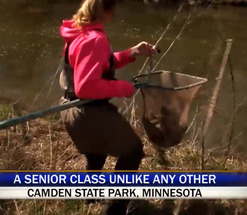 |
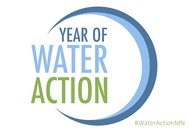
Keep Our Waters Swimmable & Fishable is the May theme
of Governor Dayton's “Year of Water Action”. Gov. Mark Dayton
encourages all Minnesotans to take a role in protecting our state’s most
precious resource for future generations. Gov. Dayton has called on
Minnesotans to work together to find solutions to keep Minnesota’s water
clean and accessible to everyone. Despite the state’s abundance of lakes,
rivers, groundwater and streams, more than 40 percent of Minnesota’s waters
are currently listed as impaired or polluted.
Back to top
|
|